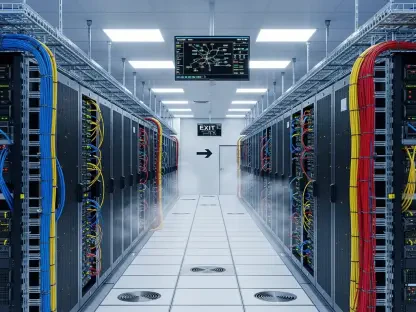The Pentagon’s new cloud contract, JWCC Next, is poised to usher in unprecedented changes in defense cloud computing strategies. With a scope expected to surpass the $9 billion Joint Warfighting Cloud Capability (JWCC) contract awarded in 2022, JWCC Next aims to integrate a broader range of services, including entire cloud ecosystems and third-party marketplaces. This innovative approach could redefine how the Defense Department (DOD) and its mission partners access and utilize cloud services, moving beyond reliance on hyperscale providers like Amazon Web Services, Google, Microsoft, and Oracle.
Evolving Cloud Ecosystems
Multi-Award Contract with Diverse Providers
JWCC Next emerges as a multi-award contract that not only involves big names in cloud-service provisions, such as Amazon Web Services, Google, Microsoft, and Oracle but also seeks to incorporate smaller vendors into its ecosystem. According to John Hale, the product management and development chief at the Defense Information Systems Agency (DISA), this initiative is designed to scale up significantly compared to its predecessor and encompass cloud ecosystems from multiple providers. The aim is to foster an environment where third-party vendors can seamlessly integrate, ensuring a more holistic and multifaceted cloud solution for the Defense Department.
This comprehensive approach means that approximately 180 cloud providers meeting DOD’s baseline cloud security requirements could be included, thus diversifying the options available to the DOD. Traditionally, the Pentagon has leaned heavily on a few hyperscale providers, which, while reliable, may not offer the full spectrum of solutions needed for more specialized or niche operations. By bringing in a wider array of providers, JWCC Next aims to create a more robust, secure, and versatile cloud environment. This move could lead to better innovation, greater competition, and ultimately, more effective and tailored solutions for various defense applications.
Leveraging Lessons from JWCC
The Defense Department is keen on applying the lessons learned from the JWCC experience to the upcoming JWCC Next initiative. JWCC has successfully awarded $2.3 billion in task orders, covering both classified and unclassified cloud requirements across the DOD. These experiences have been instrumental in shaping the strategies and objectives for JWCC Next. The DOD aims to streamline access to the wide variety of cloud services and providers, which could solve the current inefficiencies that inhibit the use of smaller but capable cloud vendors.
Adapting these lessons involves not only scaling up but also ensuring greater accessibility and integration. Integrators and mission partners have expressed a growing demand for multi-cloud solutions, indicating a shift towards platforms that resemble those available in the private sector. This requirement is particularly prominent among various defense sectors such as the Army, which seeks commercial cloud services capable of comprehensive ecosystems. By fostering an environment where integrators can easily leverage these third-party solutions, the DOD could enhance the overall effectiveness and efficiency of its cloud strategy, leading to improved mission outcomes.
Strategic Development and Expected Impact
Developing the Acquisition Strategy
The Pentagon is currently finalizing the acquisition strategy for JWCC Next and engaging in discussions with industry and mission partners, aiming to optimize the forthcoming contract. A draft request for proposal is anticipated later this year, with the contract planned to hit the market in about 18 months. This timeline reflects a deliberate and strategic approach, ensuring that all necessary considerations from security to scalability are addressed. The comprehensive nature of JWCC Next’s strategy is expected to align with evolving defense needs and technological advancements.
Engaging industry and mission partners early in the process signals a collaborative approach, which is vital for the contract’s long-term success. This collaboration will likely inform the final structure and requirements of the contract, ensuring that it is both practical and forward-thinking. The emphasis on strategic development underscores the DOD’s commitment to not only meeting current demands but also anticipating future challenges and opportunities in defense cloud computing. By incorporating feedback and insights from a diverse array of stakeholders, the contract is likely to be more robust and adaptable to changing needs.
Growing Federal Cloud Expenditures
Federal cloud computing expenditure continues to rise, reflecting the growing reliance on cloud solutions within the government sector. With $16.5 billion spent last fiscal year and projections indicating spending will exceed $30 billion by 2028, the scale and significance of cloud computing in federal operations cannot be overstated. JWCC Next is poised to be a major component of this growth, providing the necessary infrastructure and services to support the complex and evolving needs of the Defense Department.
Other significant cloud contracts within the DOD, such as the CIA’s C2E contract and the NSA’s WildandStormy contract, align with this upward trend in cloud investment. The replacement of the Joint Enterprise Defense Infrastructure (JEDI) contract by JWCC itself marked a significant shift towards more flexible and expansive cloud solutions. JWCC Next’s focus on integrating comprehensive cloud ecosystems rather than just relying on hyperscale providers is indicative of this broader strategy, aiming to enhance federal cloud capabilities and ensure that the Defense Department remains at the forefront of technological innovation.
Future Prospects
Comprehensive Cloud Solutions
The shift towards comprehensive cloud ecosystems as indicated by JWCC Next represents a significant trend in the Pentagon’s approach to cloud computing contracts. This forward-thinking strategy goes beyond simply providing cloud services; it aims to build an integrated ecosystem that can cater to a wide range of defense needs. By including third-party providers and smaller vendors, JWCC Next has the potential to offer a more versatile and robust cloud environment, which is crucial for addressing the diverse challenges faced by the DOD.
The emphasis on comprehensive cloud solutions can also foster greater innovation and competition among providers, leading to improved services and better value for the DOD. Integrators and mission partners will benefit from a more dynamic and adaptable cloud infrastructure, which can support more sophisticated and specialized operational requirements. This holistic approach to cloud computing is likely to set a new standard for future defense contracts, emphasizing the importance of flexibility, scalability, and security in today’s rapidly evolving technological landscape.
Preparing for Future Challenges
The Pentagon is initiating a groundbreaking new cloud contract called JWCC Next, which is set to bring substantial changes to defense cloud computing strategies. Expected to exceed the $9 billion Joint Warfighting Cloud Capability (JWCC) contract awarded in 2022 in both scope and ambition, JWCC Next will encompass a wider array of services, including comprehensive cloud ecosystems and third-party marketplaces. This cutting-edge strategy could radically transform how the Defense Department (DOD) and its mission partners procure and utilize cloud solutions. The initiative aims to go beyond the traditional dependence on major hyperscale cloud service providers such as Amazon Web Services, Google, Microsoft, and Oracle. By adopting this expanded and innovative approach, the DOD seeks to enhance flexibility, improve efficiency, and ensure better integration of various cloud services, ultimately redefining the landscape of defense-oriented cloud computing.









